Home » Medical Mattresses
Home » Medical Mattresses
Medical mattresses, also called therapeutic surfaces, are designed for users with reduced mobility, chronic illness, disabilities, aging, or who spend extended durations in bed such as people recovering from surgery or injury. Many medical mattresses are designed to prevent and relieve pain from pressure ulcers/bedsores and other conditions that occur from using a traditional mattress. Medical mattresses are designed for either prevention or treatment and may be made from foam, innerspring, air, gel, or a combination of these systems.
They are also known as pressure relief mattresses, pressure redistribution mattresses, therapeutic surfaces, therapeutic support surfaces, therapeutic mattresses, medicated mattresses, hospital mattresses, hospital bed mattresses, foam mattresses, medical air mattresses, healthcare mattresses, health care mattresses, and mattresses.
Pressure ulcers are localized injuries to the skin and/or underlying tissue. They are also known as bed sores, bedsores, pressure sores, pressure injuries, decubitus ulcers, or decubitus sores.
Bed sores commonly occur in patients who spend a lot of time in bed. They are often found in areas of the skin susceptible to lack of blood flow and prolonged pressure, heat/moisture, shear, friction, or multiple factors. Pressure injuries may also occur due to pressure caused by a medical device or another object. They are common over bony prominences including the heels, sacrum/coccyx (tailbone), buttocks, elbows, and ears. The most common sites for pressure injuries are the tailbone and heels.
There are 4 stages of pressure ulcers. Stage 1 pressure ulcers only affect the upper layer of skin. Stage 2 pressure ulcers break below the surface of the skin and may appear as an open wound or blister. Stage 3 bed sores break through the second layer of skin into the fat tissue and may show signs of infection. Stage 4 pressure sores are the most damaging, and may affect the muscles, ligaments, bone, or other supporting structures, such as tendons and joint capsules.
Medical mattresses can help with the prevention and treatment of pressure ulcers. Different types of mattresses are designed for different stages of pressure ulcers.
Overlays, also known as toppers, are support surfaces designed to be used on top of another surface. They provide a barrier between the patient and the surface, which is often anti-microbial, fluid resistant, and anti-fungal. Like mattresses, they may feature systems such as alternating pressure and low air loss for pressure redistribution, pressure ulcer prevention and treatment, shear/friction reduction, and microclimate control.
There are two main types of medical mattresses: prevention and treatment.
Prevention
Prevention mattresses are non-powered surfaces designed for homecare settings. They work best for patients who stay in bed for extended time periods but have no history of bed sores/pressure ulcers or other forms of skin breakdown. These mattresses are made for immersion and to minimize pressure on high-risk areas with bony protrusions, such as the scapula (shoulder blades), sacrum (near the tail bone), and heels. Prevention mattresses all have a foam base. The foam density varies across sections of the mattress to control how much the patient sinks into the bed and how much the bed raises at the sides. High-pressure areas have lower density foam for deeper immersion, so bony protrusions can sink into the mattress. Low-pressure areas are firmer such as the knees. Prevention mattresses have more rigid foam around the borders to prevent the patient from falling out of bed as easily and to assist in safe, firm transfers in and out of bed. Some examples of prevention mattresses include the Drive Gravity 7, Invacare Solace, Span Geo-Mattress UltraMax, and Span Geo-Mattress Max.
Treatment
Treatment mattresses, also known as pressure relief/redistribution and therapeutic mattresses, are often used in institutional settings including long-term care and often feature clinical positioning. There are several types of treatment mattresses including gel-foam combination, forced/static air, alternating pressure, and low air loss. Treatment mattresses have either a foam base or topper.
Gel-foam combination mattresses are non-powered (static) and provide the lowest level of treatment benefits. However, they can be used for pressure redistribution, deep immersion, and heat management since they are very cold. They do not have any moisture-wicking properties. They are best used for patients at low risk of developing pressure ulcers.
Forced/static air mattresses, or forced/static pressure mattresses, feature non-powered air cells that are calibrated based on the user’s weight for pressure relieving immersion. Air can flow throughout the mattress, so the mattress has moisture-wicking and temperature-regulating properties, as well as pressure redistribution. However, the mattress does not move the user around at all, so after a while, the patient may feel discomfort from sitting/lying in the same position. Forced air mattresses can be used for the prevention of pressure ulcers. However, they are not ideal to treat pressure ulcers.
Alternating pressure mattresses feature rows of powered air cells that alternate between inflation and deflation on a cycle for superior circulation and pressure redistribution. The cycle helps shift the user’s weight to promote circulation, prevent pressure build-up/bed sores, and promotes the healing of existing sores. Alternating pressure mattresses can prevent and treat Stage 1-4 ulcers and can be used for patients who are post-flap/post-graft.
Low air loss mattresses, also known as microclimate management mattresses, are covered in powered air cells with tiny holes created by lasers to expel air that is pumped throughout the mattress. These mattresses have moisture-wicking and temperature-regulation properties, and they are great at pressure ulcer prevention and treatment. Microclimate management mattresses decrease sweat and heat. Some loss air loss mattresses come with alternating pressure, where the air cells inflate and deflate on a cycle to relieve pressure points. The amount of air pushed through a low air loss mattress affects its moisture-wicking properties. The more air pumped through per minute, the firmer the mattress surface will be. Some low air loss mattresses can pump through over 1,000 L of air per minute, whereas others may pump through 1-2 L of air per minute. Many manufacturers will include the amount of air pumped through the mattress per minute.
There are other less popular types of hospital mattresses available, including innerspring mattresses, which feel more like traditional mattresses and are economical. However, these mattresses can increase pressure and temperature in certain areas causing bed sores. Innerspring mattresses are not recommended for patients that spend more than 10 hours a day in bed. There are also prevention and treatment bariatric mattresses available for users with a higher weight capacity.
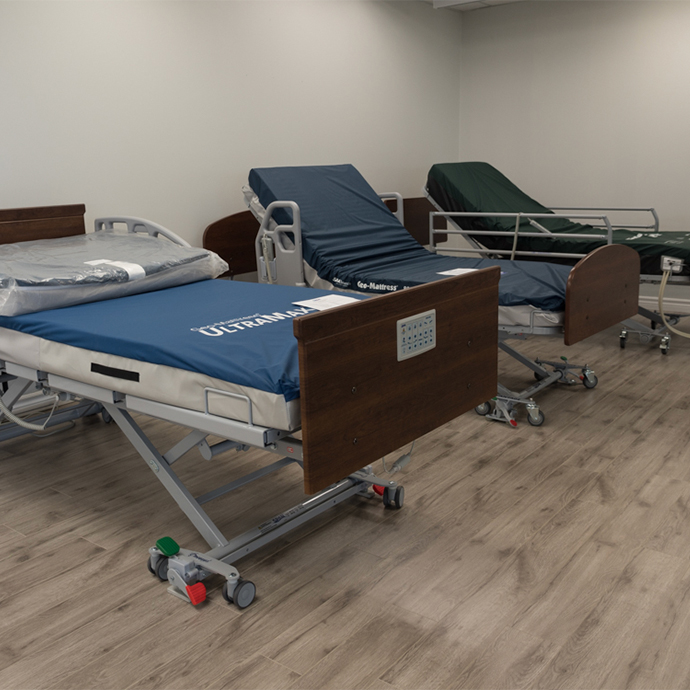
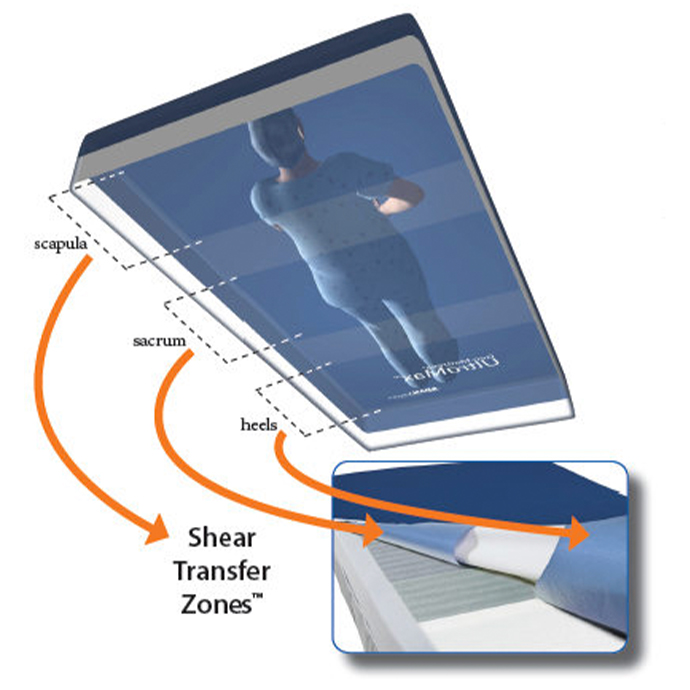
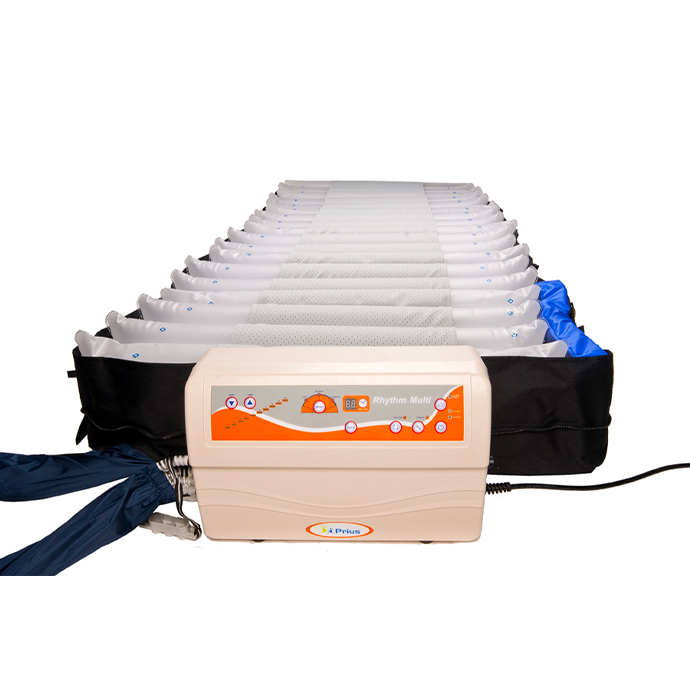
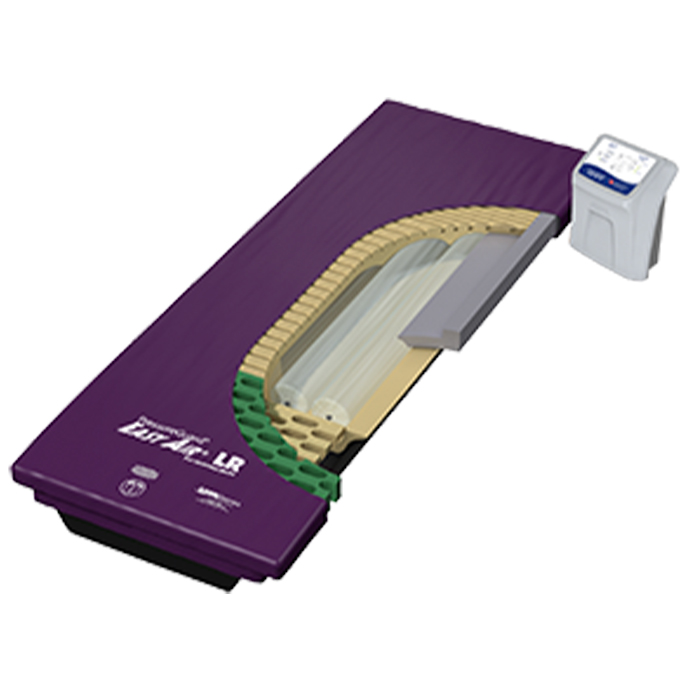
Foam base or topper
Most mattresses come with a foam base. Some come with a foam topper instead. This is an important feature for powered mattresses to maintain user comfort in case they deflate with power failure.
Firm borders
Firm borders can help prevent the patient from falling out of bed, reduce the risk of entrapment, and assist in safe transfers in and out of bed. Some manufacturers also raise the borders or provide additional protection. Span’s Safety Edge uses a two-part bolster system: the inner of the two parts bends in toward the center of the mattress, while the outer part resists compression.
Individual cells
Individual cells on the surface of the mattress can move with the patient’s body to decrease shearing which can cause pressure injuries.
Lateral rotation
This feature can be used for enhanced pressure management with some alternating pressure or low air loss mattresses. A pump automatically changes the inflation levels of the air cylinders on a scheduled cycle. This rotates the patient up to 40° from side to side, changing the load across the surface of the mattress. This feature can be useful for patients who cannot be turned manually due to pain, including users with arthritis, hip fractures or replacements, and skin conditions that cause pain upon contact. However, lateral rotation is not a replacement for manual turning and positioning. It is also a useful feature for patients at high risk of pressure injury, to heal pressure injuries, and pulmonary or respiratory issues.
Covers
Covers prevent shearing that can lead to pressure injuries through bony prominences digging into the surface. They can also provide a moisture barrier.
Shear-reduction sections
Many mattresses feature soft sections for shear reduction and to minimize pressure to high-risk areas with bony protrusions, such as the scapula (shoulder blades), sacrum (near the tail bone), head, and heels.
Foot slope
Some mattresses come with a foot section that slopes down to relieve pressure off the heels.
Auto firm and CPR valve
Low air loss and alternating pressure mattresses may come with an auto firm feature. The more air pumped through per minute, the firmer the mattress surface will be. An auto firm feature sets the mattress to pump the maximum amount of air per minute to make the surface as firm as possible. This is useful for the caregiver to lift the patient, such as to put a sling underneath their body to attach to a ceiling lift. An auto firm feature may be timed and scheduled. Some low air loss mattresses can pump through over 1,000 L of air per minute, whereas others may pump through 1-2 L of air per minute. Many manufacturers will include the amount of air pumped through the mattress per minute.
Some long-term care beds come with a CPR valve function, which is a button or lever that deflates the air and flattens the mattress quickly to create a rigid surface for CPR administration, in case of an emergency. Low air loss mattresses often come with a CPR valve.
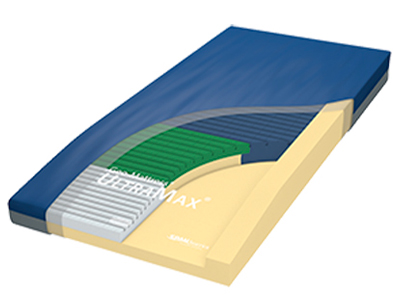
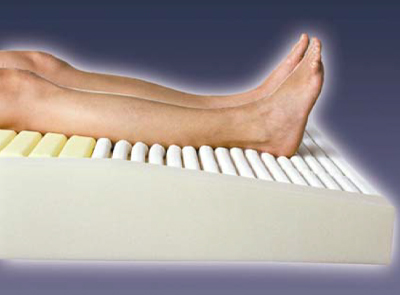
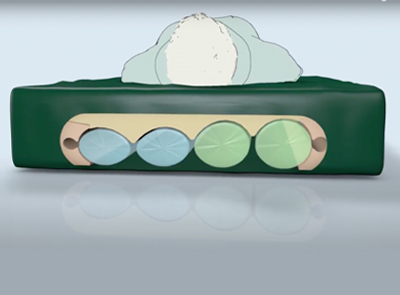
Founded in 1993 when the Internet was just starting to become important in day-to-day life, Silver Cross built its roots as relationship company. It formed partnerships with experienced dealers and installers of stair lifts, elevators and other mobility equipment in order to bridge the gap between the prospective customer and a pre-qualified, knowledgeable local dealer.